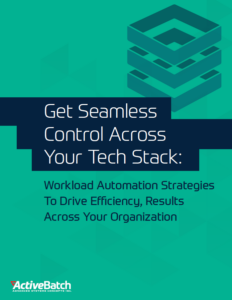5 Ways To Simplify Data Center Automation And Orchestration

What is Data Center Automation?
Data centers are the nerve centers of organizations, responsible for housing and maintaining critical data and providing resources to meet business and IT needs. As a result, data centers are increasingly complex, diverse and… not as fast or efficient as they really should be.
Data center automation is the process of automating data centers by removing the need for manual handoffs, reducing human errors and minimizing the time to value. Data center automation helps teams deliver IT services faster, while giving personnel more time to develop high-value solutions.
Orchestration takes this a step further. Instead of just automating discrete tasks, IT teams can further improve service levels by stringing those automated tasks into long-running or end-to-end processes, creating hands-off services that are reliable, efficient and easy to manage.
Drive Connectivity With APIs
Business needs are constantly changing, with departments across the organization implementing new applications every quarter. As a result, IT teams must be able to quickly connect disparate endpoints to reliably manage data across on-premises and cloud environments.
Additionally, data and tech silos continue to hamper digital transformation, isolating data within systems that were never designed to be integrated.
To meet increased demand for connectivity, many IT organizations are turning to internal APIs. A report by Mulesoft found that organizations using APIs to drive integrations were 69% less likely to face integration challenges.
This makes sense — APIs are highly reliable and can be used to connect to virtually any digital tool or cloud service. Plus, APIs are relatively easy to manage with the right tools in place. API management tools provide central repositories for internal APIs, while automation platforms can provide API adapters that enable teams to rapidly connect any endpoint, and then incorporate those connections into end-to-end processes.
Being able to integrate virtually any endpoint is key to hyperautomation efforts as well as orchestration. Having the tools to build data center processes across any operating system or environment — public cloud, hybrid cloud, multi-cloud — enables IT to keep pace with business demands, minimizing delays and backlogs of work.
Approach Real-Time Data Using Event-Based Automation
Manual handoffs can be unreliable, prone to human error and often cause delays. Date/time scheduling can help but only when a task is repeated at regular intervals, which doesn’t support dynamic demand.
In order to meet real-time data requirements, IT operations should shift from time-based scheduling to event-based automation. Event-based automation relies on the use of event triggers to kick-off processes based on IT or business events. In low-code automation tools, prebuilt triggers support a wide range of events including file and email events, completion status of predecessor jobs, system startup and more.
Event-based automation enables the use of auto-remediation workflows. Event triggers can be set up so that, if a workload overruns, fails or is delayed, the automation tool can kick-off a remediation workflow or notify IT personnel.
Additionally, event-based automation can be used to manage cloud-based resources and virtual machines. For example, if an execution server meets a certain CPU threshold, the automation tool can provision additional resources or shift an SLA-critical workload to a server with more available compute.
Event-based automation provides greater flexibility for IT teams looking to improve efficiency and reliability in the data center. More manual tasks can be automated, delays can be reduced and SLAs improved.
Don’t Settle For Unreliable Automation
Improve reliability and extensibility across your environment with the right workload automation strategies and tools.
Centralize And Standardize Governance And Monitoring
Modern data centers are no longer monolithic, which has led to a fair bit of siloing in most cases. These silos — as well as the IT and business environments they connect to — are often managed and monitored with a variety of tools. This means that governance is managed in multiple places, making it difficult to standardize practices and to gain a clear picture of enterprise processes.
An extensible automation platform can be used to streamline and standardize governance in a few key ways. By managing automated processes from a centralized location, users can:
- Simplify user permissioning by using existing LDAP accounts or Microsoft Active Directory, for example. This makes it easier to manage access rights to any object, process or application, while providing instant authentication.
- Create a centralized repository for audit trails and logs. Automation platforms typically maintain full audit trails for all user actions and instances so administrators can easily monitor for unwanted activity or track changes.
- Require additional information for any changes made to objects or processes, including who gave approval, authorized ID or any other policy requirement.
With increased transparency and control, IT can improve governance and standardize policies across environments so that it’s easier to build end-to-end processes across environments.
Additionally, having a centralized control center makes it easier to monitor processes and resources across environments. Real-time monitoring can be used to support auto-remediation and alerting, while IT operations teams can build in-depth reports to analyze all objects and properties across environments.
Orchestrate End-To-End Across Layers
Extensible automation platforms can be used to manage tasks across different layers of your data center infrastructure. For example, IT can deploy a workload automation solution in the orchestration layer and configure event-triggers or thresholds for compute, provisioning and deprovisioning resources as needed, without manual intervention.
A single end-to-end process can therefore tie together access management, configuration management, network automation, big data and a self-service portal to deliver on-demand information directly to end-users.
Set A Goal For A Hands-Off Data Center Automation
Whether you call it a lights-out data center, a hands-off data center or autonomous IT, the goal should be to design a data center that manages itself without the need for human intervention. This is obviously a blue-sky goal — it might be unattainable for a variety of reasons. But your team should know that it’s something everyone needs to strive for nonetheless.
By automating as much as possible you free up critical resources and manpower to tackle higher-value tasks. By freeing up the operations team, more time can be spent in development or devops. Centralized, automated processes are easier to test, iterate and optimize, enabling your team to find new efficiencies and to deliver new solutions faster.
Start small — automate discrete tasks that are repeatable and easy to automate, such as checking for open source updates and patching IT infrastructure. Then begin to assemble those pieces together into longer-running processes using a drag-and-drop automation tool.
The next step is to create end-to-end processes that can heal themselves, using real-time monitoring, auto-remediation and heuristics or machine learning. Automation vendors are beginning to offer AI solutions that analyze your automation environment and provide granular, customized actions to optimize your environment, bringing a self-healing automation environment closer than ever before.
Ready to simplify your data warehousing with workload automation?
Schedule a demo to watch our experts run jobs that match your business requirements in ActiveBatch. Get your questions answered and learn how easy it is to build and maintain your jobs.








